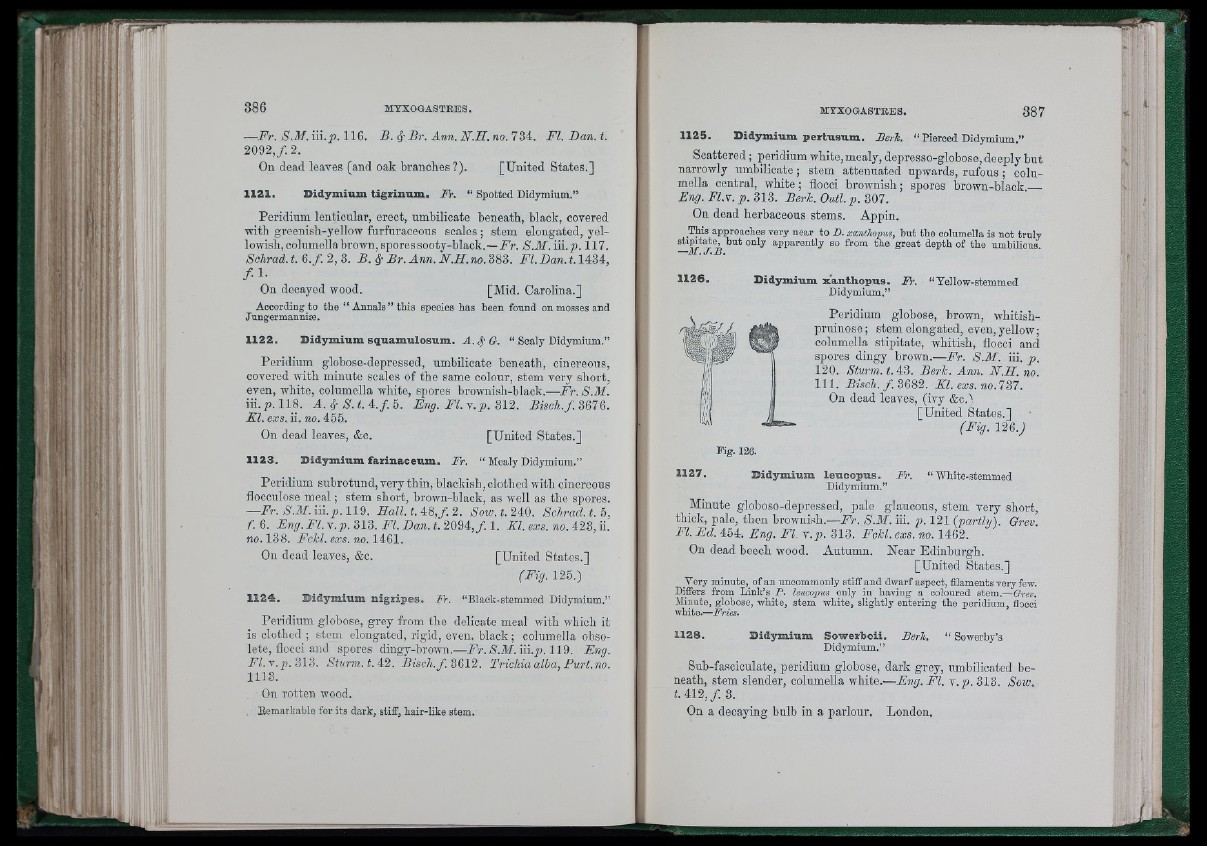
to-'
> !■ », Í
f h
—Fr. S.M. 116. B. / B r. Ann. N .H . no. 734. F l. Han. t.
2092, f . 2 .
On dead leaves (and oak branches ?). [United States.]
11 2 1 . D id ym ium tig z in um , Fr. “ Spotted Didymium.”
Peridium lenticular, erect, umbilicate beneath, black, covered
with greenisb-yellow furfuraeeous scales ; stem elongated, yellowish,
columellabrown,sporessooty-blaok.—Dr. N.M. iii.)). 117.
Schrad. t. e. f. 2, 3. B. 4 Br. Ann. N.H.no.383. Fl.Han.t.U34:,
/ • I-O
n decayed wood. [Mid. Carolina.]
According to the “ Annals’’ this species has been found on mosses and
Jungermannise.
1 1 2 2 . D id ym ium sq u am u lo sum . A .^ 'O . “ Scaly Didymium.”
Peridium globose-depressed, umbilicate beneath, cinereous,
covered witb minute scales of the same colour, stem very short,
even, white, columella white, spores brownish-black.—Dr. N.M.
iii. p. 118. A. 4 S. t. i . f . 5. Eng. FL r .p . 312. Bisch.f. 3676.
Kl. exs. ii. no. 455.
On dead leaves, &c. [United States.]
1 1 2 3 . D id ym ium fa z in a c eum . Fr. “ Mealy Didymium.”
Peridium subrotund, very tbin, blackish, clothed witb cinereous
floccniose m e a l; stem short, brown-black, as well as the spores.
—Dr. N.M. iii.)9.119. Hall. t.48. f . 2 . S ow.t.240. Schrad. t.5 ,
f. 6. Eng. F l. r .p . 313. Fl. Dan. t. 2 0 9 4 ,/. 1. Kl. exs. no. 423, ii.
no. 138. Ec/cl. exs. no. 1461.
On dead leaves, &o. [United States.]
(Fig. 125.)
1 1 2 4 . D id ym ium n ig z ip e s . Fr. “Black-stemmed Didymium.”
Peridium globose, grey from tbe delicate meal with which it
is clothed ; stem elongated, rigid, even, black; columella obsolete,
flocci and spores dingy-brown.—Dr.N.M.iii.)?. 119. Eng.
F l . r . p . 313. Sturm.t. 42. Bisch. f . 3612. Trichia alba, Purt.no.
1113.
On rotten wood.
. Eemarkable for its dark, stiff, hair-like stem.
1 1 2 5 . D id ym ium p e z tu sum . BBeerrkk, “ Pierced Didymium.”
Scattered ; peridium white, mealy, depresso-globose, deeply but
narrowly umbilicate ; stem attenuated upwards, rufous ; columella
central, white ; floooi brownisb ; spores brown-black.__
Eng. Fl.r. p. 313. Berh. Outl.p. 307.
On dead herbaceous stems. Appin.
This approaches very near to D. mnthopus, but the columella is not truly
stipitate, but only apparently so from the great depth of the umbilicus.
-M\ f . JT.. BIR.
1 1 2 6 . D id ym ium x a n th o p u s . Fr.
Didymium.”
“ Yellow-stemmed
Peridium globose, brown, wbitisb-
pruinose; stem elongated, even, yellow;
columella stipitate, whitish, flocci and
spores dingy brown.—Dr. S.M. iii. p.
120. Sturm, t. 43. Berh. Ann. N .H . no.
111. Bisch. f . 3682. Kl. e x s.n o .l3 1 .
On dead leaves, (ivy &c.^
[United States.]
(Fig. 126.;
Fig. 120.
1127. D id ym ium leu c o p u s . Fr.
Didymium.”
“ White-stemmed
Minute globoso-depressed, pale glaucous, stem very short,
tbick, pale, then brownish.—Dr. S.M. iii. p. 121 (partly). Grev.
Fl. Ed. 454. Eng. FL r .p . 313. Fold. exs. no. 1462.
On dead beech wood. Autumn. Near Edinburgh.
[United States.]
Very minute, of an uncommonly stiff and dwarf aspect, filaments very few.
Differs from Link’s P. leucopus only in having a coloured stem.—Orev.
Minute, globose, white, stem white, slightly entering the peridium, flocci
white.—Fries.
112S. D id ym ium S ow e zb e ii.
Didymium.”
Berk “ Sowerby’s
Sub-fasciculate, peridium globose, dark grey, umbilicated beneatb,
stem slender, columella wbite.—E n g .F l. r .p . 313. Sow
t. 412, f . 3.
On a decaying bulb in a parlour. London.